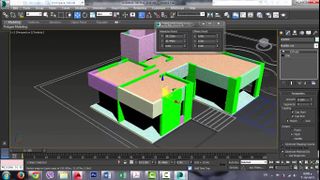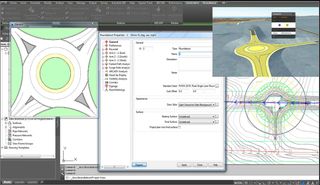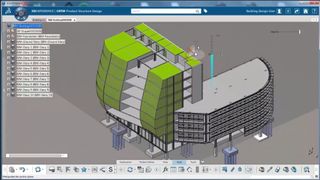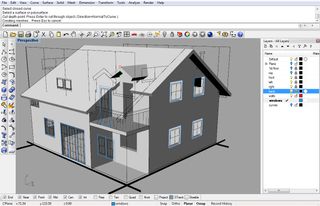Best Architecture Software 2018
Designing buildings is a complex task that’s all about detail as much as the grand vision of the designer. The architectural software enables the original concept to be honed into a practical work or home space.
The first computing tools to aid architects addressed the logistical issues of producing the numerous drawings needed for any sizeable project.
Now they’re focused on providing a new workflow, and elements such as structural analysis and evacuation management, to mention just a couple of their capabilities.
Generating drawings for construction teams is just a small part of their remit, although doing this efficiently and tracking successive changes is still very important.
Here is a selection of the best software tools to provide a solid foundation for any building project.

1. 3DS Max
A flexible modelling system with powerful plugins
- 3D modelling and animation
- AutoCAD file support
- Powerful Plugins
- A steep learning curve
3D Studio existed before Windows 3.x and was one of the first tools to offer hardware accelerated rendering of 3D images.
Its value is in creating visuals and fly-through animations to promote a project, rather than design it from the floor up.
Along with the vanilla 3DS Max, you can choose three special flavors designed for Media work & Entertainment, Production design & manufacturing, and an Architecture, Engineering and Construction collection.
That last collection includes products we’ll mention separately, including AutoCAD, Civil 3D. Revit and also InfraWorks, Navisworks Manage.
Those are just the major applications, as it also has tools for structural analysis, steel detailing, building performance analysis and even vehicle path calculations.
The whole bundle along with 3DS Max costs $2,755 (£2,104) per year, or less per year if you sign up for two or three years.
That’s a tempting offer, considering that 3DS Max costs $1,505 (£1,149), a little less than AutoCAD costs.

2. AutoCAD Civil 3D
AutoCAD with a civil engineering twist
- Command line interface
- Versatile approach
- Occasional stability issues
- Cloud isn’t well supported
Modeling and drawing are only two of the functions needed from CAD by architects and builders. There are many others, many of which are addressed by AutoCAD Civil 3D.
Designed to work with other Autodesk products, specifically AutoCAD, Revit and 3DS Max, it offers a design and documentation pipeline for Building Information Modelling (BIM) workflows.
One useful ability is the integration of survey images with terrain modeling, roads, service schematics and constructional geometry. All these elements are placed into a single highly annotated package. Allowing engineers to focus on their specific area, but also see how their changes might interfere with others.
Civil 3D costs $2,155 (£1,645) per annum to license, or like 3DS Max it can be licensed with other Autodesk products in the Architecture, Engineering & Construction Collection for $2,755 (£2,104) per year.

3. AutoCAD Architecture
Yet more tools from Autodesk
- Efficient keyboard shortcuts
- Autodesk integration
- Specific training required
- Not BIM or Revit
AutoCAD has long been a staple of constructional engineers and architects, so much that Autodesk built a specific version for building design work called AutoCAD Architecture.
To speed up the process, it provides pre-built objects for walls, doors and Windows, and mechanisms for creating elevations, sections and plans from model geometry.
The only big caveat to this application is how firmly aligned to older working practices it is, where many in the building trade are moving towards a Building Information Modelling application (BIM) future. For those customers Autodesk offers Revit.
Cost is $1,575 (£1,203) per annum, or you can get it as part of the Architecture, Engineering & Construction Collection for $2,755 (£2,104) per year.

4. CATIA
Can model buildings just as well as jets
- Huge model complexity
- Very precise model data
- Easy to learn
- Very expensive
We first encountered CATIA over thirty years ago, when the creators Dassault Systèmes started to promote their in-house solution to other companies.
Originally conceived to precision model military hardware, it can easily handle complex architectural problems and generate finely detailed models.
Where many CAD systems added collaboration and security controlled distribution later, CATIA had this from its inception. And, more recently it expanded those coordination features to embrace Cloud functionality.
With such powerful and fully featured software Dassault don’t post exact pricing. Instead, you have to ask for a quote. That hints at a high cost per seat, although the number of companies that use it also indicates that it is probably worth what they’re demanding.

5. Chief Architect
A software house building kit
- Easy to use
- Powerful smart features
- On Windows PC and Mac
- Expensive
Substantially more homes are built than giant office complexes or retail parks, and that is the forte of Chief Architect.
This tool can be utilised by homeowners wanting to remodel, home builders, interior designers and architects creating unique residences.
Depending on specific needs there is a product selection that begins very modestly and focuses, for example, on Interiors. Or, you can spend much more on their Premier product that handles complete buildings with all their details.
Using Premier or Architect Interiors you to rapidly construct 3D models of exterior and interior spaces and then project those into 2D plans and elevations.
Premier costs $2,795 (£2,135) and Architect Interiors costs $1,995 (£1,524) per annum and then $495 (£378) per year renewal for either. Or, you can rent them for roughly 10% of those costs per month.

6. Revit
BIM-orientated design tool for architects
- Highly efficient tool
- Smart object connectivity
- Little overlap in AutoCAD commands
- Lacks an intuitive interface
Part of a whole new generation of Autodesk products aimed specifically at architectural studios that handle complex projects and need BIM (Building Information Modelling), Revit not only enabled the design and modelling of a building, but the coordination of multiple engineers collaborating on the same scheme.
Designers using Revit are working with objects, not a vector between two points, and that allows them to work quickly and with confidence.
However, even if they both use a command line interface, this isn’t like AutoCAD. And, those coming from that discipline might struggle initially with the transition. Once they’ve scaled the steep learning curve, Revit can offer a competitive edge over those that are just using traditional design applications.
Revit starts at $2,250.00 (£1,718) per annum and comes in the same collection that AutoCAD Architecture and 3D Studio Max offer for architects.

7. Rhino 6 for Windows
The king of curved surfaces
- Very powerful modeller
- Plugins and scripting
- Third-party services
- BIM functionality is an add-on
Most CAD applications are great with straight lines and less marvellous with anything curved. Rhino was designed from inception to handle curved lines, meshes and NURBS surfaces of high complexity, like those in the features of a human face or the sweeping curves of a super-car.
For architectural design, Rhino can easily model the complex intersections of curved roofing or any part of the structure that isn’t inherently straight.
As a platform, it isn’t a specialised tool. Instead, it caters for add-ins and the Grasshopper visual programming system to enable it to be tailored to specific tasks.
This makes Rhino a highly flexible tool that can be tweaked to automate complex modelling and detailing operations for those projects that need them.
A single license for Rhino 6 on Windows PC costs €995 (£880, or $1,160). Unusually for CAD software, you are not forced to upgrade to the next release and upgrades generally cost half that of a new license.

8. Sketchup Pro 2018
A user-friendly modelling tool
- Free version for home use
- Very easy to learn
- No built-in rendering
- Not a collaborative tool
Originally a Google-backed project, Sketchup is now owned and developed by Trimble, who release a new version at least once a year.
As a start point for anyone entering 3D modelling, Sketchup is as easy as CAD gets. After a few easy to follow tutorials, designers should be able to work rapidly to construct complex solid geometry using it.
Tthe free release has made Sketchup very popular, generating a large and active community of Sketchup users on hand to help the inexperienced. The user-base has also contributed to an extensive object library, a vast resource of pre-constructed parts to drop into any project.
It might not be suitable for designing a building entirely, but it is an excellent tool for rapidly prototyping a design when it is still at a conceptual stage.
Sketchup Pro costs $695 (£531) per seat, and rendering costs extra depending on the rendering software you choose.
You can find architecture 3D models here
